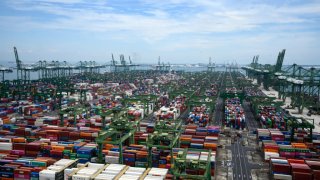
- Singapore's economy is "definitely operating above its potential" as it continues to face labor shortages from the pandemic and strong manufacturing activity, according to Brian Tan, senior regional economist at Barclays.
- "We have a lot of labor shortages in the economy. So considering how constrained we are in terms of supply, demand does look like it's a little bit too strong," he added.
- Although a stronger Singapore dollar is likely to weigh on export momentum, Tan said it could be "precisely" what the country needs to cool some of the inflation pressures.
Singapore's economy is "definitely operating above its potential" as it continues to face labor shortages from the pandemic and strong manufacturing activity, according to Brian Tan, senior regional economist at Barclays.
Although a stronger Singapore dollar is likely to weigh on export momentum, Tan said it could be "precisely" what the country needs to cool some of the inflation pressures that are rising from strong demand across the board, including in exports and manufacturing.
"The Singapore dollar framework is exactly meant to slow down exports as the Singapore dollar appreciates relative to the policy band, and that will naturally slow down the rest of the economy," Tan added.
After the The Monetary Authority of Singapore's announcement last Thursday that it would take a "further calibrated step" to tighten monetary policy in order to fight inflation, the Singapore currency jumped up almost 0.7% to S$1.3963 per dollar, with economists expecting further tightening in October.
Tight labor market
Get Boston local news, weather forecasts, lifestyle and entertainment stories to your inbox. Sign up for NBC Boston’s newsletters.
Tan said that although a strong manufacturing sector is desired, "very strong activity" is contributing to the country's inflation pressures as the tight labor market is driving wages up.
The country has fully reopened its borders and foreign workers have been coming in, but they are being "absorbed quicker than they are being replenished," with many of them being hired in the travel and services sectors.
Similarly, a pandemic-induced labor shortage in the country's manufacturing sector means there aren't enough workers to keep up with demand, Tan said, adding that it is also trying to find and hire workers, "so there's very strong competition right now."
Money Report
His comments came after Singapore's non-oil domestic exports (NODX) expanded for the 19th straight month, increasing by 9% year on year last month, though it was down from 12% in May, according to official data from Enterprise Singapore released on Monday.
The largest contributors to the growth in the NODX were from Malaysia, Indonesia, and the United States. Electronic shipments increased by 4.1% in June, a sharp drop from the 12.9% growth in May, while non-electronic NODX rose by 10.6% in June, following the 11.7% rise in the previous month, according to the government agency.
Strong manufacturing and exports will be good for the economy, but Singapore does not have enough workers to fulfill the rising demand, Tan said. "It may be prudent to slow [manufacturing and export activity] in order to bring the inflation pressures under control until supply can improve going forward," Tan added.
He said inflation in Singapore will be "key to watch" in the second half of the year.
Even though the reopening of travel borders has alleviated some of the labor shortages, Tan said recovery will be gradual.
Inflation will likely remain "quite sustained" in the second half, and may start to cool only toward the end of the year, he said.






